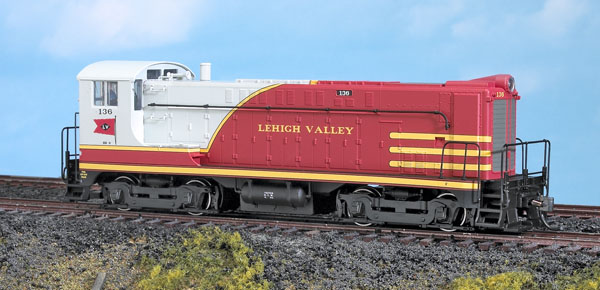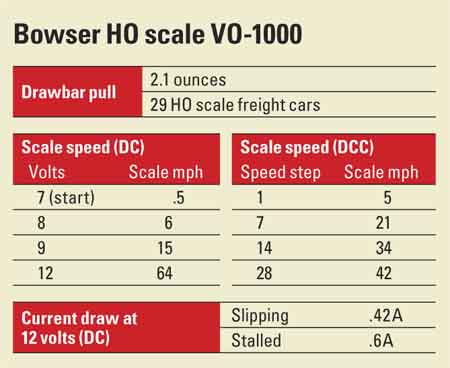direct-current model or equipped with a dual-mode Digital Command Control decoder. Bowser’s version has a lot of separate details and a smooth drivetrain geared for slow-speed switching. It comes in several road names, including two with trolley poles that were used on the prototype to trigger signals when running on an electric railway.
A war baby. Baldwin was a late entry into the diesel switcher market, focusing its early diesel efforts on road engines. Baldwin started building the VO1000 in 1939 along with the lower-powered VO660, which resembled its bigger brother but had a shorter body. Boosted by government allocation of locomotive production in World War II, Baldwin built 548 of the 1,000-hp VO1000s between 1939 and 1946.
Bowser’s model represents the second VO1000 body style, used from 1941 to 1946, which had a slightly pointed nose, rectangular front grill, and top radiator. Bowser’s model matches the prototype’s dimensions as shown in the Model Railroader Cyclopedia – Vol. 2, Diesel Locomotives [Kalmbach Books, out of print].
Our sample came in the Lehigh Valley’s vivid as-delivered scheme. Four of these switchers were delivered to the LV in 1944. Two were scrapped in 1969, and the other two sold.
The inner workings. The hood is held in place with four tabs that snap into the underframe. Prying these tabs with a small flat screwdriver let me wiggle the hood loose. Underneath, the DCC
decoder is attached by a screw and pins to a plastic platform above the motor, flywheels, and back gear tower. The speaker enclosure sits above the front gear tower. The light-emitting diode front and rear lights are secured to the hood and the cab.
All four wheelsets are powered, and all pick up power from the rails. On our sample, all were in gauge. The die-cast metal Kadee magnetic knuckle couplers were likewise mounted at the correct height. The cab features a detailed interior with a painted engineer figure.
The locomotive’s underbody has an arch-shaped enclosure on either side of the fuel tank to make room for the five-pole can motor and its dual brass flywheels. This enclosure isn’t on the prototype, but it’s unobtrusive.
The paint job was even and opaque, with crisp definition at the edges. However, there were a few glitches. In the Lehigh Valley paint scheme, the yellow stripe that separates the red and gray
areas of the body should be bordered with a thin black line on both sides. On the left side of our sample locomotive, the black line between the yellow and the gray was missing. Furthermore, our sample’s paint had a few tiny nicks.
In DC, the locomotive’s sounds and headlight came on at 6 volts (V). At 7V the model moved under 1 scale mph – perfect for slow-speed coupling. It reached 64 mph at 12V, which is close to the prototype’s maximum speed as listed in the 1941 Simmons-Boardman Locomotive Cyclopedia of American Practice.
Out of the box on a DCC layout, the model moved at 5 scale mph at speed step 1 of 28 steps. At speed step 28, it topped out at 42 mph, slower than the prototype’s top speed. Using 128 speed steps the model rolled at 1.7 mph in speed step 1 with the same top speed at step 128. The decoder has many programmable configuration variables, which allow you to adjust the speed performance and sound features. You’ll find a user manual at www.soundtraxx.com.
Our workbench force meter measured the model’s pulling power at more than 2 ounces, enough to pull 29 HO scale freight cars on straight and level track.
A steady worker. Though Baldwin’s boxy design didn’t win the VO1000 any beauty contests, the utilitarian switcher worked hard for years in yards across the country. With its upgraded details and electronics, Bowser’s models are likewise ready to go to work on your transition-era HO scale railroad.
Manufacturer
Bowser
P.O. Box 322
Montoursville, PA 17754
www.bowser-trains.com
Road names: Lehigh Valley, Great Northern, Pacific Electric (with trolley poles), Patapsco & Back Rivers (Bethlehem Steel), Southern Pacific (with trolley poles), U.S. Steel, Western Pacific
Era: 1939 to 1970s
Features
- All-wheel drive and electrical pickup
- Detailed cab interior with painted engineer figure
- Etched-metal windshield wipers
- Five-pole can motor with dual brass flywheels
- Flexible plastic handrails and grab irons
- Kadee couplers at correct height
- LED headlights
- Minimum radius: 18″
- Prototype-specific details
- SoundTraxx Tsunami DCC sound decoder (optional)
- Weight: 8 ounces















